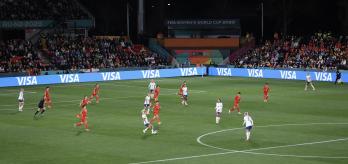Figures 1.1 and 1.2 display the match outcomes and average points per game for teams with more and less possession than their opponent. In Qatar, teams with less possession than their opponents surprisingly won slightly more games (26 wins versus 23) and averaged 1.45 points per game (PPG), outperforming teams with more possession, who registered 1.31 PPG.
However, a different pattern emerges when analysing the recent FIFA Women’s World Cup. In this case, teams with more possession won 38 of the 64 games (59%) and achieved and average PPG of 1.98, while teams with less possession only managed 13 wins (20%) and an average PPG of 0.81. Interestingly, the success of possession-based teams intensified as the tournament progressed. Out of the 16 knockout games, 12 were won by the team with more possession, while only one team with less possession secured a victory.
These findings indicate that possession-oriented styles of play were clearly more successful in Australia and New Zealand than in Qatar.
Possession gap and success
Figures 1.3 and 1.4 delve deeper into the relationship between possession and success by examining the impact of the “possession gap” on the probability of winning. Instead of simply considering whether a team has “more” or “less” possession, performances are broken down by “how much more” or “how much less” possession a team has.
Each tournament consisted of 128 performances (two performances per game in a tournament of 64 games). These performances were divided into six categories that indicate the size of the possession gap between one team and their opponent. The bar sizes in figures 1.3 and 1.4 indicate the average points per game (PPG) accumulated by each category. For example, in Qatar, there were 28 performances where a team had 15% to 30% more ball possession than their opponent. Out of these 28 performances, teams won nine times, lost 14, and drew five, resulting in an average of 1.14 PPG.
Looking at all six categories in figure 1.3, there is no indication that having more possession than the opponent leads to a higher likelihood of winning. In fact, the trend line for the Qatar tournament shows a slight negative correlation between success and ball possession. Remarkably, the most successful category is the one where teams had a possession deficit of 15% to 30%, followed by the group with a possession deficit of 30% or more.
On the other hand, in Australia and New Zealand, figure 1.4 indicates a positive relationship between the size of the possession gap and success. The most successful category in this case is the one where teams had a positive possession differential of 30%, while the least successful category was the one with a negative possession differential of 30%. However, it is important to note that this observation does not apply to all groups. For example, the group with 15% to 30% less possession was slightly more successful than their direct competitors (those with 15% to 30% more possession).
Summary
In summary, the relationship between possession and success in football remains unclear. While possession-dominant teams generally found success in the women’s competition, they have been relatively ineffective in the men’s tournament. It can be concluded that high shares of possession do not automatically increase the chances of winning. Both possession-based and defensive styles of play can be successful under certain circumstances and when executed well. However, neither approach guarantees success on its own, regardless of the amount of possession a team has.
To further investigate the reasons behind these different findings, other factors that contribute to a team’s effectiveness in and out of possession must be considered. One such factor is the number of attempts a team creates in relation to the number of attempts they concede, referred to as “net attempts” in this study.

















